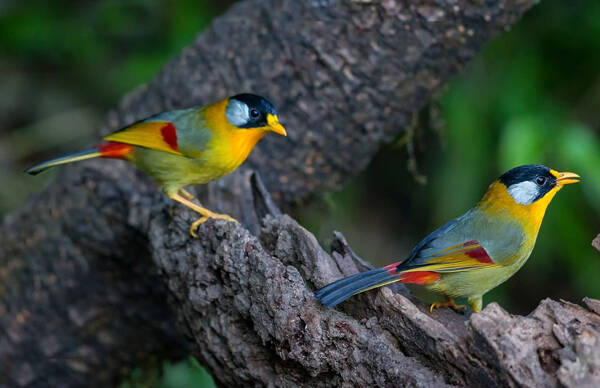Leiothrix argentauris
IUCN
LCBasic Information
Scientific classification
- name:Leiothrix argentauris
- Scientific Name:Leiothrix argentauris,Silver-eared Mesia,Yellow-billed Jade, Colorful Lovebird
- Outline:Songbird
- Family:Passeriformes Thrush family Acacia
Vital signs
- length:14-18cm
- Weight:22-29g
- lifetime:About 10 years
Feature
Lively and bold, not afraid of people
Distribution and Habitat
Native distribution: Bhutan, Cambodia, China, India, Indonesia, Laos, Malaysia, Myanmar, Thailand, Vietnam.
Extinct area: Bangladesh.
In China, it is mainly distributed in southern Guizhou and western, southern and eastern Yunnan, southern Guangxi and southeastern Tibet.
It mainly inhabits evergreen broad-leaved forests, bamboo forests and forest edge shrubs below 2,000 meters above sea level.
Appearance
The male has an orange-yellow forehead, black from the top of the head to the back of the neck, face, eyes and cheeks, silver-gray from behind the eyes to the ear feathers, a brown-olive, tea-yellow or orange-yellow collar on the lower part of the back of the neck, and the sides of the neck are also tea-yellow or orange-yellow. The rest of the upper body is olive-gray, and the waist is stained with green. The upper tail coverts are red, the tail feathers are dark gray-brown or black-brown, and the outer tail feathers have orange-yellow or light yellow edges; the wing coverts are the same color as the back, and the flight feathers are dark brown, except for the innermost secondary flight feathers, which are the same color as the back; the outer edges of the rest of the flight feathers are golden yellow, and the base of the outer vanes of the flight feathers from the third primary flight feather onwards is vermilion, forming a distinct vermilion wing spot. The chin, throat, and chest are
Details
Silver-eared Mesia has 9 subspecies.

Silver-eared Mesia often moves alone or in pairs, and sometimes in groups, especially in autumn and winter. It is lively and bold, not afraid of people, often jumping in the undergrowth or bamboo groves and in the open space in the forest. It rarely rests on trees and does not fly far. People can often get very close to it.
Silver-eared leiothrix mainly feeds on insects such as beetles, ladybugs, ants, and lepidoptera larvae. It also eats fruits and seeds of plants such as strawberries, raspberries, figs, and grass seeds, and sometimes eats crops such as grains and corn.
The breeding season of silver-eared leiothrix is from May to July. It nests on shrubs under the forest. The nest is cup-shaped and mainly made of grass leaves, grass stems, roots and other materials. Each nest lays 3 to 5 eggs, and the size of the eggs is 21 to 23.4 mm × 15 to 17 mm. The male and female take turns incubating the eggs, and the incubation period is 14 days.
The global population of Silver-eared Leiothrix has not been quantified, but it is a common species in its native range. It is relatively rare in parts of Nepal (del Hoyo et al. 2007).
Listed in the IUCN Red List of Threatened Species: Least Concern (LC), assessed in 2012.
Listed in the List of Terrestrial Wildlife with Important Economic and Scientific Research Value under State Protection issued by the State Forestry Administration of China on August 1, 2000 (item 509).
Listed in China's "National Key Protected Wildlife List" (February 5, 2021) Level 2.
Protect wildlife and eliminate game.
Maintaining ecological balance is everyone's responsibility!








